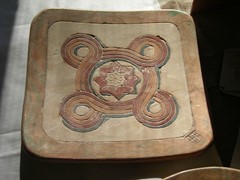Ars Canusina – craftsmanship inspired by Romanesque art
Our journey in the footsteps of Matilda of Canossa will also let us discover interesting traditions inspired by her story, such as Ars Canusina. It was 1930 when a young psychiatrist from Reggio, Maria Bertolani Del Rio, in collaboration with experts in drawing, painting, decoration and embroidery, began translating the iconographic motifs of Canossa’s tradition, a quite singular expression of Romanesque art particular to the territory influenced by Matilda’s culture, in an extensive graphic repertoire. The aim was to develop manual craft activity as a form of therapy for the young psychiatric patients at the school Dr. Bertolani Del Rio directed. Thus it was that in 1935 an album was published entitled Ars Canusina, which set out the canons of this new arts and crafts discipline. The book was a compendium of drawings obtained by rubbings, that drew attention to the quite original geometric patterns.
This gave birth to the Canusino school of embroidery which, under the skilled guidance of expert embroiderers, turned out to be not only a revolutionary and effective therapeutic exercise, but also resulted in craftwork that merited a place in the artistic panorama for its refined and distinctive iconography. With the new therapeutic tendencies of the second half of the 20th century, the school’s activity was shelved and Ars Canusina became part of the local economy, unhappily falling victim to a sudden crisis in the sector. On the 25 September 1948, Maria Del Rio registered the brand name “Ars Canusina”, obtaining an exclusive patent to safeguard the criteria of original production that included embroidery, ceramics, leatherware, chased metalware, and bas reliefs in wood and stone. On her death, the Priest of Casina inherited the brand name on her wishes, and in 1990, passed it on to the Municipality of Casina.
In 1990, the owner set up a Committee to safeguard Ars Canusina, entrusting it with all the tasks of supervising and promoting both production and the brand name itself. The Committee’s efforts have unearthed from the dust of attics one of the most touching and original stories of the Italian 1900s.
The reworking of this Romanesque art repertoire, whose origins lie in the friezes of cathedrals, churches and castles, in floor mosaics and illuminated codices from Matilda’s century, is what makes Ars Canusina special today. This quite particular form of craftsmanship, supervised by the Ars Canusina Consortium, founded in 2007 by the Municipality of Casina and the local GAL development agency, is currently represented by the production of certain artists working in sophisticated workshops, who are heirs of the centuries-old local artisan tradition and who work in various sectors such as embroidery, ceramics, decorated glassware, wrought ironwork, sculpture and stonemasonry, engraved earthenware and artistic lighting. The subjects are geometric or are based on anthropomorphic figures and naturalistic motifs which feature recurring symbolic and aesthetic notions from Romanesque art. The works are produced using the most ancient of techniques with respect for decorative canons from artistic tradition. The products made in this way cannot fail to recall the original design.
